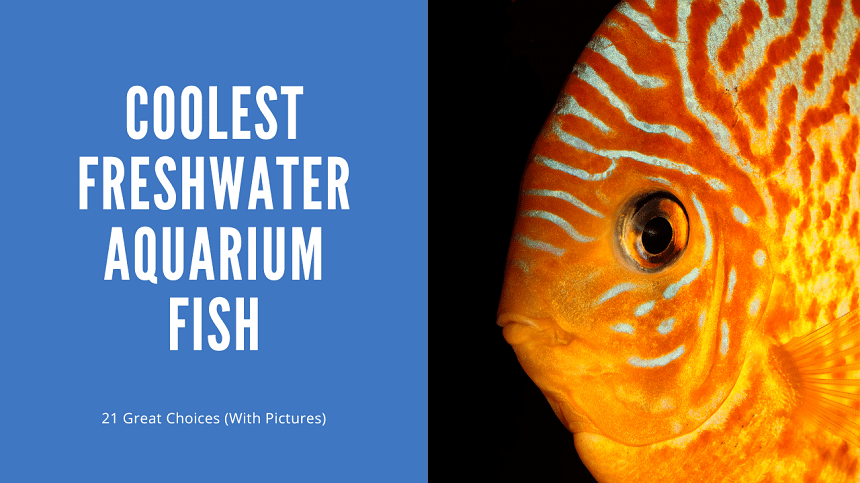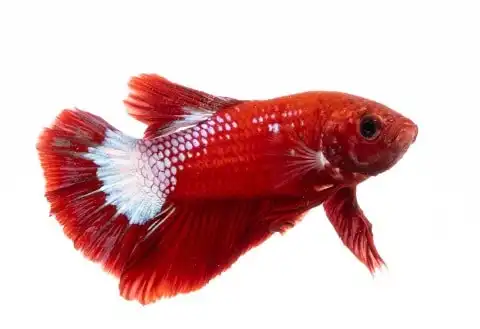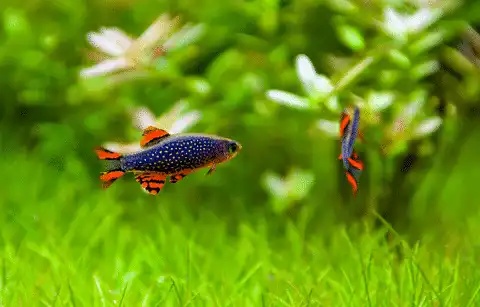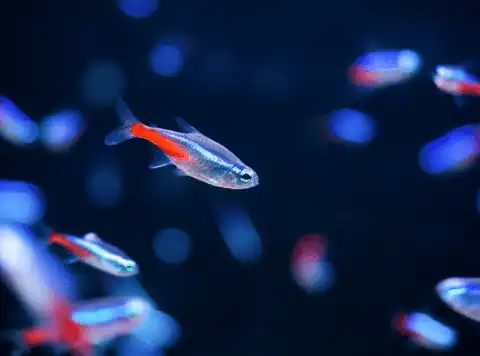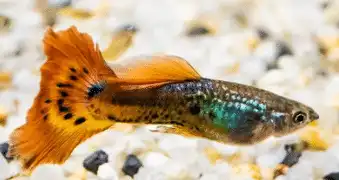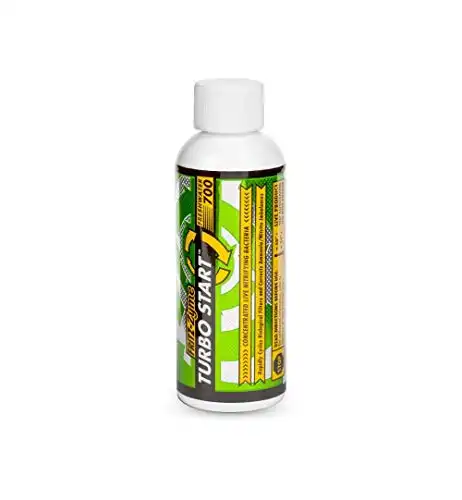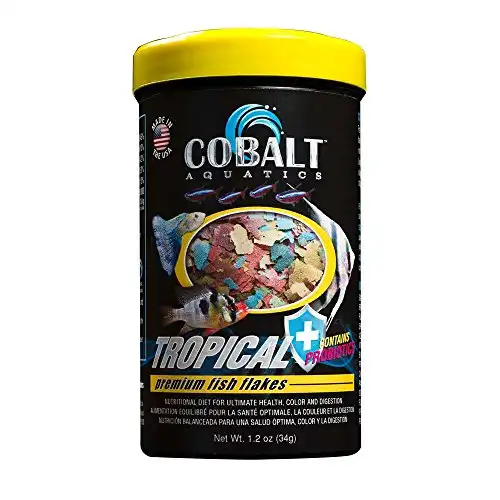Thank you for visiting! By the way… any links on this page that lead to products on Amazon and other stores/partners are affiliate links Aquarium Store Depot earns a commission if you make a purchase.
Are you looking for some of the coolest freshwater aquarium fish for your aquarium? Maybe you’re setting up a new tank, or maybe you just want a few new fish for your community tank. Either way, we’ve got you covered. This article introduces 21 awesome fish that you will love watching in your tank!
If you’re new to fish keeping, you’ll find loads of great info here too. That’s right, we’re covering all the basics you need to know before getting your first freshwater fish, so make sure you read until the end.
Let’s dive straight into it!
Key Takeaways
- Research your favorite fish’s needs before adding them to your tank- each species is different.
- Choose peaceful community fish if you want more than one species in your tank. Your tank will be a much more harmonious place if you avoid aggressive fish.
- Use the best equipment you can afford and keep up with regular maintenance to keep your fish healthy.
How To Choose
One of the biggest challenges when picking out new aquarium fish is selecting the perfect fit for your tank. Walking into a big fish store and being surrounded by all the beautiful exotic fish can be pretty overwhelming, especially when you don’t know exactly how big they will grow and how much space they need.
I recommend doing your research at home before you go out and buy fish, and that’s what this article is all about!
Tank Size
Size matters when you’re choosing a freshwater fish tank. It’s important to consider how much space you have for an aquarium. If you already have a tank set up at home, you also need to consider what kind of fish can live in your aquarium.
Read up on the adult size of the fish you like as well as the minimum tank size that they need. Starting with a big enough tank can save you a lot of trouble in the future!
Larger aquariums will need a dedicated stand or cabinet to stand on, remember, fish tanks are heavy. Your aquarium should also have a tight-fitting hood because most fish are surprisingly strong jumpers!
Care Level
Factoring in the physical space needed to keep your fish is a good starting point, but take your time to research their care too. Some aquarium fish are much easier to keep than others, and beginners should always choose fish with easy care requirements.
So what makes some fish easier to keep than others? Care level depends on factors like:
- Diet– Some fish have very specific diets or need live foods only. Fish that can feed on prepared foods like flakes and pellets are easier to care for.
- Water Quality– Some fish need very high water quality and are not likely to survive beginners’ mistakes. Hardy fish are the best choice for first-time fish keepers.
- Tank Environment– Some fish need specific substrates, water flow, and other specialized setups. Fish that are happy in general tank conditions are the easiest to care for.
Temperament
Temperament is very important when choosing an aquarium fish species. Some semi-aggressive species like betta fish can actually make great beginner fish, it is just important to keep them alone or choose their tank mates carefully. Peaceful fish are always the safest bet when putting together a community tank.
Water Parameters
Water parameters are the chemical conditions in your aquarium water. Different fish prefer different parameters, although some fish have more specific needs.
It is best to test your water before you buy your fish. That way you can choose fish that will be comfortable in the water that you can provide.
21 Of The Coolest Freshwater Aquarium Fish
Now that you know what to look for when choosing aquarium fish, it’s time to meet 21 awesome freshwater aquarium fish that you can choose from!
Some fish just have that wow factor, and each of the species in this list will impress you. For each species in the list, I’ll cover some of the most important care requirements and some cool facts about what makes them unique.
We have a video below from our YouTube channel. If you like it, be sure to subscribe as we post new ones every week. We go into more detail in our blog below.
There’s also a list of information about each fish that you should keep in mind:
- Scientific Name
- Origin
- Care Level
- Adult Size
- Minimum Tank Size
- Temperament
- Swimming Level
- Diet
- Water Temperature
- pH
Let’s get started!
1. Betta
Use Coupon Code ASDFISH at Checkout
Betta Fish are one of the most beautiful varieties of freshwater fish available in the hobby. Easy to care for with plenty of varieties!
- Scientific Name: Betta splendens
- Origin: Southeast Asia
- Care Level: Moderate
- Adult Size: 2.5-3 inches
- Minimum Tank Size: 5 gallons
- Temperament: Aggressive
- Swimming Level: Mid/top levels
- Diet: Carnivorous. Provide flakes/pellets, live/ frozen foods
- Water Temperature: 75-80°F
- pH: 6.5-8
The betta fish is hands down one of the coolest freshwater aquarium fish in the hobby. These beautiful fish are full of color and full of attitude.
In fact, betta fish are also known as Siamese fighting fish because they were originally bred to fight for sport. Today we prefer to enjoy these wonderful pets for their beauty and personality, so it’s important to keep just one betta fish in the same tank.
Betta fish are a great option for new fish keepers because they can be kept in just a 5-gallon tank, although they need a filter and a heater. These colorful freshwater fish can also be kept with some other species of peaceful freshwater tropical fish if they have plenty of space in a community aquarium.
2. Freshwater Angelfish
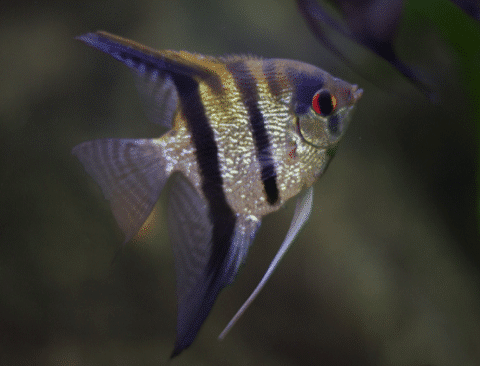
- Scientific Name: Pterophyllum scalare
- Origin: Tropical South America
- Care Level: Easy
- Max Size: 6 inches
- Minimum Tank Size: 30 gallons
- Temperament: Peaceful, semi-aggressive when breeding
- Swimming Level: Top/ mid-levels
- Diet: Omnivorous. provide flakes/pellets, live/ frozen foods
- Water Temperature: 78-84°F
- pH: 6.5-7.2
Angelfish are unique cichlids from South America that are available in many different breeds with awesome colors and patterns. These tropical fish have very tall, flat bodies with really long fins. In fact, their bodies are taller than they are long!
Angelfish are easy to care for, but they need a pretty big tank. 29 gallons is the minimum tank size, but a 55 gallon would be a better bet in the long term. Angelfish are pretty peaceful for cichlids, but they will eat smaller fish, so choose their tank mates carefully.
3. Dwarf Gourami

- Scientific Name: Trichogaster lalius
- Origin: Pakistan, Bangladesh, India
- Care Level: Moderate
- Max Size: 2.5-3 inches
- Minimum Tank Size: 10 gallons
- Temperament: Semi-aggressive
- Swimming Level: Mid/top levels
- Diet: Omnivorous. Provide dried, frozen, and live foods
- Water Temperature: 72-82°F
- pH: 6-7.5
The dwarf gourami is a beautiful freshwater aquarium fish that is great for smaller aquariums. These cool labyrinth fish come from the same family as the betta fish, although they are not nearly as aggressive. In fact, dwarf gouramis can be kept in a pair or small group if they have enough space.
There are many different dwarf gourami breeds, including the beautiful powder blue gourami and the colorful flame gourami.
4. Rainbow
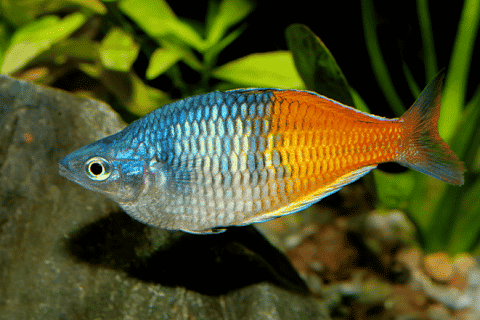
- Scientific Name: Various
- Origin: Australia, Southeast Asia, etc.
- Care Level: Easy-moderate
- Max Size: 1.5 – 6 inches
- Minimum Tank Size: 30 – 55 gallons
- Temperament: Peaceful
- Swimming Level: Mid/ top levels
- Diet: Omnivorous. Feed dried, frozen/live foods, and vegetable matter
- Water Temperature: Various
- pH: Various
Rainbowfish are not a single species but rather a group of fish from the Melanotaeniidae family. Most of these fish come from Australia and Southeast Asia but they are common in the aquarium trade today.
These colorful freshwater fish are active swimmers that need plenty of swimming space to stay healthy. Most rainbowfish make excellent community fish that are easy to care for.
Each species grows to a different size and has different care needs, so be sure to research the specific needs of your rainbow fish before bringing them home.
5. Dwarf Cichlids
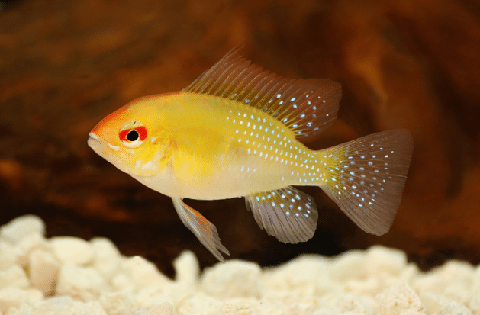
- Scientific Name: Various
- Origin: Africa, Asia
- Care Level: Easy to advanced
- Max Size: 1-5 inches
- Minimum Tank Size: 10 – 20 gallons
- Temperament: Peaceful- semi-aggressive
- Swimming Level: Bottom/mid-levels
- Diet: Various
- Water Temperature: Various
- pH: Various
Dwarf cichlids are the smaller fish species in the cichlid family. These tropical freshwater fish are amazing fish for aquarists who don’t have the space to keep the larger species.
There are many different species, and each needs a slightly different setup and slightly different care. Dwarf cichlids tend to be less aggressive than their larger relatives too, which makes them really cool fish for carefully planned community tanks.
Some beautiful species like the German blue ram can actually be pretty shy and need plenty of hiding places to feel secure. Make sure you read up on the individual care needs of any dwarf cichlid species before adding it to your aquarium.
6. Pea Puffer
- Scientific Name: Carinotetradon travancoricus
- Origin: India
- Care Level: Moderate
- Adult Size: 1 inch
- Minimum Tank Size: 10 gallons
- Temperament: Aggressive
- Swimming Level: Top/ mid-levels
- Diet: Carnivorous. Provide live and frozen foods
- Water Temperature: 72-82°F
- pH: 7-8
The Pea puffer ( AKA Dwarf puffer fish) is a super-cool nano fish with loads of personality. They are adorable freshwater aquarium fish, but they can be pretty aggressive and they don’t always get along great with other fish species (video source).
Pea puffers are perfect for fish keepers looking for a small species that doesn’t need a lot of space. These curious fish are an excellent choice for a small, heavily planted aquarium.
Thes dwarf puffers eat small snails, which they will hunt for themselves if you add some to the tank. They should also be fed live and frozen foods like brine shrimp, mosquito larvae, and blood worms.
7. Honey Gourami
One of the more peaceful Gourami fish available in the hobby. Has a unique yellow coloration and only grows up to 2 inches in length
- Scientific Name: Colisa chuna/ Trichogaster chuna
- Origin: Bangladesh, Nepal, India
- Care Level: Easy
- Adult Size: 2 inches
- Minimum Tank Size: 15 gallons
- Temperament: Peaceful
- Swimming Level: mid/ top levels
- Diet: Omnivorous. Provide flakes/pellets, live/ frozen foods
- Water Temperature: 72-81°F
- pH: 6-7.5
The honey gourami is another cool fish with a peaceful nature. These interesting little fish have beautiful colors and make great additions to community tanks with similar-sized fish.
Honey gouramis are tropical freshwater fish from Asia. They are relatively hardy and make a good choice for new fish keepers. These colorful fish look great too and are available in many different breeds including yellow and red color morphs.
8. Wagtail Platies
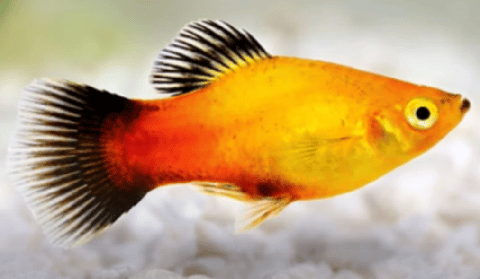
- Scientific Name: Xiphophorus maculatus
- Origin: Central America
- Care Level: Easy
- Adult Size: 2-3 inches
- Minimum Tank Size: 15 gallons
- Temperament: Peaceful
- Swimming Level: Mid/ top levels
- Diet: Omnivorous. Provide pellets, flakes, dried and frozen foods
- Water Temperature: 64-78°F
- pH: 7-8
The Wagtail platy is one of the coolest platy breeds in the aquarium hobby. These unique fish have bright red bodies with black fins and a black tail.
These peaceful community fish are very easy to care for and breed, which makes them ideal for beginners who want a really colorful fish.
9. Sailfin Mollies
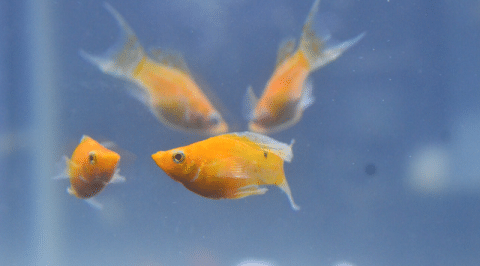
- Scientific Name: Poecilia latipinna
- Origin: Southern United States and Mexico
- Care Level: Easy
- Adult Size: 5 inches
- Minimum Tank Size: 30 gallons
- Temperament: Peaceful
- Swimming Level: Mid/ top levels
- Diet: Omnivorous. Provide pellets, flakes, dried and frozen foods.
- Water Temperature: 70-79°F
- pH: 7-8.5
Sailfin mollies are cool fish from the guppy family. These large livebearers have huge dorsal fins on their backs, which is where they get their interesting name. Sailfin molly fish grow pretty large, so it’s important to give them a tank of at least 29 gallons.
Sailfin mollies come from the same family as guppies and platy fish. These fish are called livebearers because they give birth to live babies instead of laying eggs. This makes them super easy to breed, even for beginners!
10. Chili Rasboras
Use Promo Code ASDFLIPPROMO
A great nano schooling fish. Males display brighter colors. Best in groups of 6 or more
- Scientific Name: Boraras brigittae
- Origin: Southeast Asia
- Care Level: Easy
- Adult Size: 0.8 inches
- Minimum Tank Size: 5 gallons
- Temperament: Peaceful
- Swimming Level: Top/ mid-levels
- Diet: Carnivorous. Provide flakes, live, and frozen foods.
- Water Temperature: 68-82°F
- pH: 4-7
Chili Rasboras are a tiny schooling species of freshwater fish. In fact, these cool black and orange rasboras are one of the smallest fish in the aquarium trade!
Chili rasboras are tropical fish that are perfect for a small, heavily planted aquarium. They can be pretty shy around larger species, however, so keep them in a species-only tank or with other very small fish.
11. Glass Catfish

- Scientific Name: Kryptopterus vitreolus
- Origin: Thailand
- Care Level: Moderate
- Adult Size: 4 inches
- Minimum Tank Size: 30 gallons
- Temperament: Peaceful
- Swimming Level: Mid-level
- Diet: Carnivorous. Provide dried, frozen and live foods
- Water Temperature: 72-82°F
- pH: 6.5-7.5
Glass catfish are cool freshwater fish with a really strange look. These peaceful community fish are transparent, which means you can see right through them and even see their bones!
Glass catfish are very social animals and it’s important to keep them in a group of at least 6. These unique freshwater fish can also be kept with other peaceful tropical fish that enjoy the same water parameters.
12. African Cichlids

- Scientific Name: Varied
- Origin: Africa
- Care Level: Moderate – advanced
- Adult Size: 2 -12+ inches
- Minimum Tank Size: 30 gallons
- Temperament: Semi-aggressive – Aggressive
- Swimming Level: All levels
- Diet: Varied. Including pellets, live/ frozen foods, vegetables, and algae
- Water Temperature: 74-80°F
- pH: Varied. Usually 7+
African cichlids are some of the most colorful freshwater fish in the aquarium hobby. In fact, a tank full of African cichlids can look just like a saltwater reef tank!
There is a huge number of different African cichlid species in the hobby, and each one needs to be researched carefully before adding them to your tank. It’s better to be cautious because African cichlids can be aggressive fish and often have pretty specific care needs.
13. Celestial Pearl Danio
A great-looking danio fish. Males are more colorful than females. A midway dwelling fish
- Scientific Name: Celestichthys margaritatus
- Origin: Myanmar and Thailand, Southeast Asia
- Care Level: Moderate
- Adult Size: 0.75 inches
- Minimum Tank Size: 10 gallons
- Temperament: Peaceful
- Swimming Level: Mid-level
- Diet: Omnivorous. Provide dried and frozen/live foods
- Water Temperature: 68-78°F
- pH: 6.5-7.5
The celestial pearl danio is also known as a galaxy rasbora or CPD. These peaceful community fish are a social species, so you’ll need to buy a small group of them.
Celestial pearl danios have beautiful colors, and the males in particular are very attractive. These shoaling fish are ideal for aquarists who would like to put together a small aquarium with live plants.
14. Discus
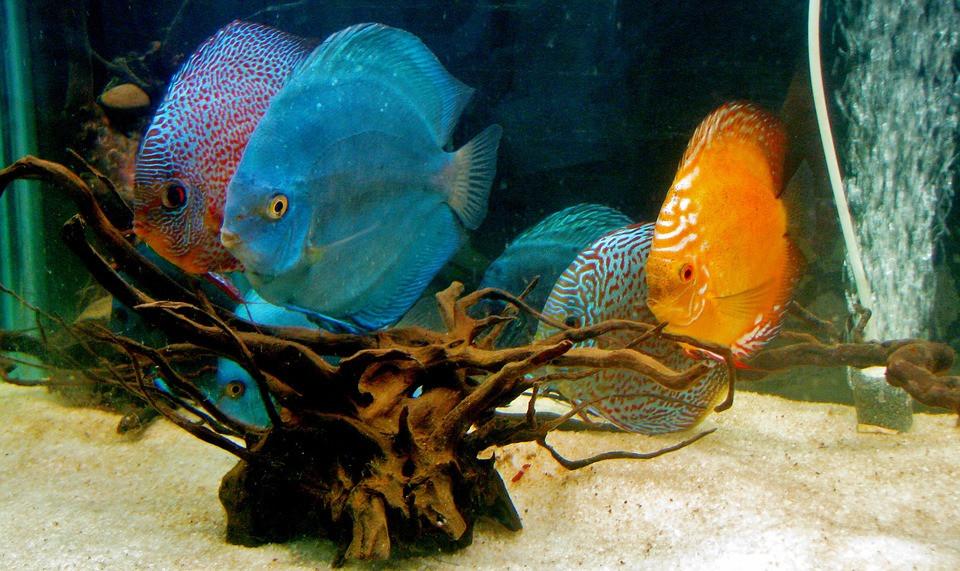
- Scientific Name: Symphysodon aequifasciatus
- Origin: South America
- Care Level: Advanced
- Adult Size: 6-9 inches
- Minimum Tank Size: 75 gallons
- Temperament: Peaceful
- Swimming Level: Mid-level
- Diet: Omnivorous. Provide pellets, flakes, vegetables, and live/frozen foods
- Water Temperature: 82-89 °F
- pH: 6-6.5
The discus cichlid is a magnificent freshwater tropical fish from South America. Discus fish prefer slightly warmer water than most other fish, so keep that in mind if you’re setting up a community tank.
The discus fish is one of the most sought-after home aquarium fish in the world because they have such bright colorful patterns and such a unique body shape. These beautiful fish are a good choice for more experienced aquarists.
15. Neon Tetra
Use Promo Code ASDFLIPPROMO
One of the most popular freshwater community schooling fish available in the aquarium trade. Great neon blue colors!
- Scientific Name: Paracheirodon innesi
- Origin: South America
- Care Level: Easy
- Adult Size: 1 inch
- Minimum Tank Size: 10 gallons
- Temperament: Peaceful
- Swimming Level: Mid-level
- Diet: Carnivorous. Provide dried and frozen/live foods
- Water Temperature: 70-79 °F
- pH: 6-7
If you’re looking for a small exotic fish for a community tank, look no further than the neon tetra! These peaceful schooling fish are easy to find at most fish stores and just as easy to care for.
Neon tetras get along really well with other species of small fish, so you don’t have to worry about any conflict with your other cool fish. These tropical fish are highly social, so pick up a group of at least 6. You’ll love watching a school of neon tetras hang out in your freshwater tank! They the smaller cousin of the Cardinal Tetra.
16. Archer
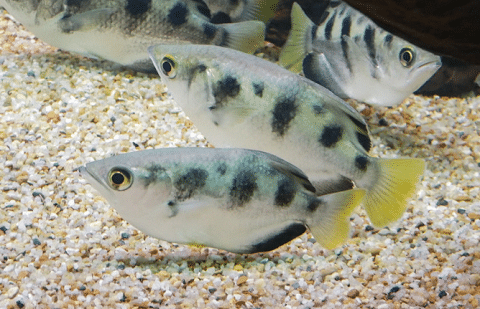
- Scientific Name: Toxotes spp.
- Origin: Asia & Australia
- Care Level: Advanced
- Adult Size: up to 12 inches
- Minimum Tank Size: 110 gallons
- Temperament: Aggressive
- Swimming Level: Top level
- Diet: Carnivorous
- Water Temperature: 77-88°F
- pH: 6-8
Archer fish are one of the most interesting tropical fish that you can keep in a freshwater aquarium. These exotic freshwater aquarium fish actually hunt for bugs above the water by spitting water at them!
Most archerfish are actually brackish water fish, so you’ll need to look for freshwater species like the small-scale archerfish if you have a freshwater tank. Archer fish are carnivores, so they are not safe to keep with smaller fish.
17. Gold Barbs
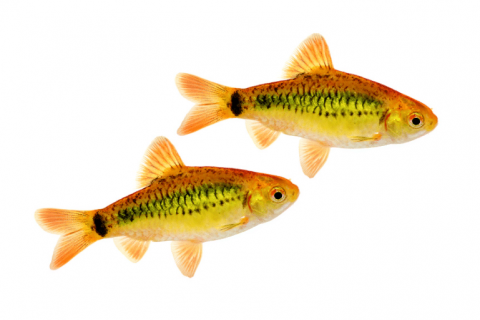
- Scientific Name: Barbodes semifasciolatus
- Origin: Vietnam, Laos, Taiwan, China
- Care Level: Easy
- Adult Size: 2.5-3 inches
- Minimum Tank Size: 20 gallons
- Temperament: Peaceful
- Swimming Level: Mid/bottom levels
- Diet: Omnivorous. Provide dried frozen/live foods and algae
- Water Temperature: 61-75°F
- pH: 6-8
The gold barb is a stunning little schooling fish that should be kept in groups of 5 or more. These fish are naturally green but they have been bred to have a bright golden color with amazing shining scales. Breeding males also develop bright red fins which really adds color to your aquarium!
These peaceful community fish can be kept in an unheated aquarium, although they will need good filtration and plenty of swimming space to stay healthy.
18. Fancy Guppies
An undemanding fish that is a livebearer. Many varieties available
- Scientific Name: Poecilia reticulata
- Origin: South America
- Care Level: Easy
- Adult Size: 1-2.5 inches
- Minimum Tank Size: 10 gallons
- Temperament: Peaceful
- Swimming Level: All levels
- Diet: Omnivorous. Provide dried and frozen/live foods
- Water Temperature: 63-82°F
- pH: 7-8.5
Guppies are one of the coolest freshwater fish and an amazing choice for everyone from beginners to experienced fish keepers. Fancy guppies are just regular guppies that have been bred to show certain colors, patterns, or fin types.
Fancy guppies are hardy fish with bright, colorful patterns. They are very easy to care for and they will happily breed in most freshwater aquariums.
19. Fancy Goldfish
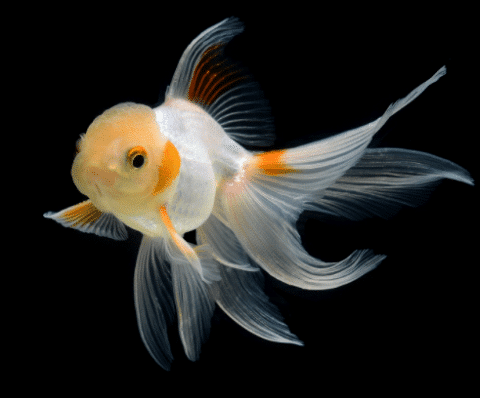
- Scientific Name: Carassius auratus
- Origin: East Asia
- Care Level: Moderate
- Adult Size: 6-8 inches
- Minimum Tank Size: 20-30 gallons
- Temperament: Semi-aggressive
- Swimming Level: All levels
- Diet: Omnivorous. Provide dried foods, live/frozen foods, vegetables
- Water Temperature: 68-74°F
- pH: 7-8
Fancy goldfish are classic aquarium fish that make amazing pets. There are many amazing goldfish breeds to choose from ranging from types with long fins to those with strange, bulging eyes!
Fancy goldfish are not as easy to care for as you might think, however, and they definitely won’t be happy in a bowl. These freshwater fish need a tank of at least 20 gallons to stay healthy.
20. Flowerhorn Cichlid
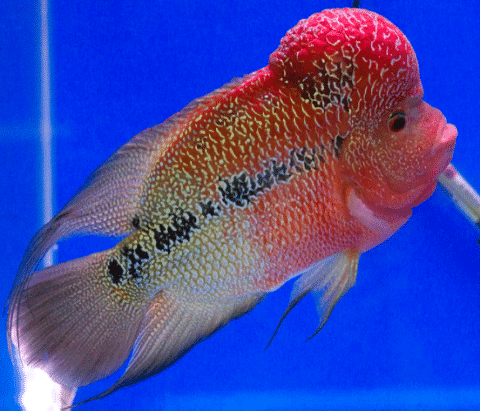
- Scientific Name: Hybrid
- Origin: Hybrid
- Care Level: Moderate
- Adult Size: 12-15 inches
- Minimum Tank Size: 75 gallons
- Temperament: Aggressive
- Swimming Level: All levels
- Diet: Omnivorous. Provide pellets, live/frozen foods, vegetables
- Water Temperature: 75-86°F
- pH: 6.5-8
The flowerhorn cichlid, is an awesome fish that makes a great pet for more experienced fish keepers. These fascinating fish are not a natural species but rather a hybrid that was bred for the aquarium trade from more than one wild cichlid.
Flowerhorn cichlids have amazing colors and their most distinctive feature is the large bump on the top of their heads. These fish grow really large (up to 15 inches) so they need a large tank to stay healthy.
21. Glofish
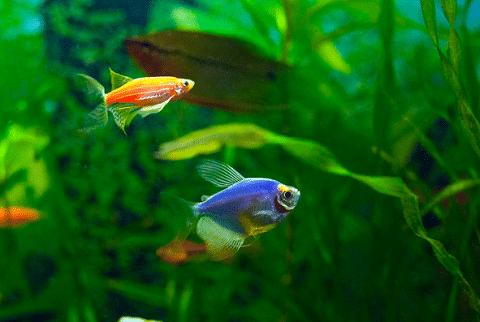
- Scientific Name: Various
- Origin: Various
- Care Level: Easy-moderate
- Adult Size: 2 – 6 inches
- Minimum Tank Size: 5 – 55 gallons
- Temperament: Peaceful – aggressive
- Swimming Level: Mid/top levels
- Diet: Omnivorous. Provide flakes, pellets, live and frozen foods
- Water Temperature: Various
- pH: Various
Glofish are fascinating freshwater fish with amazing colors. These fish come in awesome shades like cosmic blue, electric green, galactic purple, moonrise pink, Starfire red, and sunburst orange. Their bright colors are actually the result of artificial genetic modification, so you won’t find any of these neon fish in the wild.
There are many cool freshwater fish in the Glofish lineup, including tetras, danios, bettas, barbs, and freshwater sharks. The danios and tetras are very peaceful fish, but the others can be more aggressive.
Each Glofish species has different needs, so be sure to research your favorite species before you add them to your fish tank.
Preparing For Your Freshwater Fish
Have you chosen your favorite freshwater aquarium fish? Before you go ahead and buy them, you’ll need a great tank for them to call home.
Tank Setup Checklist
If you already have a tank setup at home, you can go ahead and skip this section. If you’re just starting out, go through this list carefully and get to know each item.
Let’s get started and run through the basics of what you’ll need!
Hardware Essentials:
- Aquarium with hood
- Filter
- Heater
- Substrate
- Decorations like rocks, driftwood, and aquarium-safe ornaments
- Aquarium lighting
Water Chemistry and Maintenance Essentials:
- A water test kit
- Water conditioner/dechlorinator
- Gravel vacuum or other water change system
Other Recommended Items and Optional Extras:
- Small quarantine tank, complete with heater and filter
- Aquarium background
- Thermometer
- small, fine mesh net
- Airstone and pump
- Live plants
Cycling a New Tank
Once you have everything you need, the next step is to set up and cycle your aquarium. It can take a few weeks for a healthy colony of beneficial bacteria to build up in your filter media, so take this time to do as much research as possible into the needs of the fish you’re going to buy.
It can be tough to wait out your aquarium cycle. If you’ve already brought your fish home without cycling your tank, you can ask a friend with an established aquarium for help. By adding a little filtration media from an established tank, you can jump-start the cycle in your own tank.
Another great alternative is to use a liquid bacteria product like Turbo Start 700 and do a fish-in cycle. Just be sure to keep a close eye on your water parameters if you go this route.
Fritz Turbo Start is known in the industry as the fastest acting nitrifying bacteria you can purchase. This 700 version is specialized for freshwater tank and has my highest recommendation
Quarantining New Fishes
Quarantining new fish is very important, especially if you are adding new fish to an existing tank. You never know if the new fish you bought is sick, and of course, you don’t want to introduce any illness to your existing aquarium.
I recommend putting new fish into a small quarantine tank for about 4 weeks before adding them to your main display tank. You can keep an eye on their health during this time and treat them individually if they show any signs of illness.
You can skip this step if you’re starting out with a single fish like a betta or a school of the same species.
Acclimating Your Fishes
Shipping and moving fish from tank to tank can be pretty stressful for your pets. The biggest shock often comes when they are moved from one source of water to the other. The problem is that the water conditions at your local fish store might be pretty different from the water in your tank, so how do you put fish into new water without causing shock?
The best way to add new fish to a tank is to acclimate them slowly. You can do this by floating the bag your fish came in at the surface of your aquarium. Leave the bag for a few minutes to slowly adjust to the water temperature of your tank.
Next, you can add a small amount of your aquarium water to the bag. Wait 10 to 15 minutes and repeat this process until you think all of the water in the bag is now your tank water. You’ll need to remove some water from the bag as you go to prevent it from spilling out into your tank.
Net the fish out of the bag and add them to your tank when the acclimation is complete. The water in the bag should be drained away outside of the tank to avoid introducing any unwanted organisms or parasites.
Caring
Once your aquarium is set up and you’ve introduced your new pets, you can sit back and enjoy the fascination of watching these beautiful creatures. But how do you keep them happy and healthy in their new home? Read on to learn how to care for your fish.
Feeding
Different fish species have different diets. Most aquarium fish can be fed with commercially made dried foods like flakes, pellets, granules, and wafers. Some products are made for specific species while other fish foods are great for most tropical fish.
Best Tropical Fish Flake Food
Cobalt offers a premium level flake food with probiotics. A color enhancing formula that works great for all tropical fish
What to Feed
I recommend choosing a regular dried food for your fish that you can provide on a daily basis, and then supplementing their diet once or twice a week for a more balanced diet.
Great supplements include live or frozen animals like bloodworms and brine shrimp, as well as vegetables like peas and zucchini.
How To Feed
Feed your fish once or twice a day. You should provide just enough food for the fish to finish in a minute or two.
Uneaten food will sink to the bottom of the tank where it can spoil and cause water quality issues. If you add too much food by accident, go ahead and remove as many of the leftovers as possible.
Maintaining Your Tank
Keeping your fish tank clean and healthy requires regular maintenance and water testing. Use your aquarium test kit to monitor your water quality and parameters each week to work out the perfect schedule for your tank.
You’ll need to perform a partial water change regularly to keep your nitrate levels down, and this is a great time to clean your glass, suck up waste from the bottom of the tank, and perform any other maintenance tasks.
Caring For The Sick Fishes
Fish can be affected by quite a wide variety of illnesses, just like us. Unfortunately, this is something that all fish keepers have to deal with at one stage or another. Being prepared can make all the difference, although you can never be sure about what kind of illness might occur.
Hospital Tank
I recommend keeping a small quarantine tank that can also be used as a hospital tank for treating sick fish. This way you can separate sick fish from healthy ones, just in case the illness is contagious. It will also make treating and monitoring a sick fish much easier.
Find the Cause and Treat the Problem
The biggest cause of illness in freshwater fish is stress from poor water quality, incorrect parameters, and injuries from other fish. Identifying the cause of the problem is your first priority, that way you can treat it more effectively.
Keeping some basic supplies on hand like aquarium salt and Ich-X is a good idea because they can treat many common fish illnesses.
Where To Buy
Most of the fish in this post are common species that you’ll find by visiting your local fish store. Many fish keepers do not have a decent, aquarium supply store nearby, but that’s no reason not to get started in this wonderful hobby. These days you can get your freshwater aquarium fish (and everything else you need) delivered to your door! I highly recommend Flip Aquatics if you are looking for smaller fish.
Use Promo Code ASDFLIPPROMO
Founded in 2010. Robert and his team at Flip Aquatics have set the standard for conditioned freshwater fish. One of the best selections of freshwater shrimp and nano fish on the internet
FAQs
How do you keep a nonsaline tank cool?
Some fish like their water on the cooler side. This can be difficult if the temperature in your house gets really high in the summer. The best way to solve this problem is to keep your fish tank in a cool, air-conditioned room or to use an aquarium chiller or cooling fan.
Which are the smartest nonsaline fishes?
We don’t know exactly which freshwater fish is the smartest, but goldfish are probably close to the top of the list! Cichlids like Oscars can be pretty smart too, and even the good old betta or Siamese fighting fish can be trained to do some fun tricks.
Which are the most exotic nonsaline fishes?
There are so many amazing freshwater fish in the hobby that it’s impossible to pick just one! It’s hard to look past the amazing discus fish though. These gorgeous fish come in so many amazing colors and patterns, and their disk-shaped body is really unique. If you venue to all freshwater fish, Koi Fish definitely take the crown as the most expensive freshwater fish in the hobby!
Final Thoughts
The incredible variety of fish in the aquarium trade is what makes this hobby so much fun. Don’t be intimidated by all the options though, there’s a fish species on this page for any fish keeper!
If you’re looking for more information, go ahead and explore the rest of the Aquariumstoredepot website – We have loads of in-depth articles and educational resources for you to explore. If you are looking for saltwater fish check out our beginner saltwater fish guide.
Which fish do you think is the coolest of them all? Tell us about your favorite cool fish in the comments below!
- About the Author
- Latest Posts
I’m thrilled that you found Aquarium Store Depot! Here you’ll find information on fish, aquariums, and all things aquatics related. I’m a hobbyist (being doing this since I was 11) and here to help other hobbyists thrive with their aquariums! I adhere to a high quality Editorial Process and Review products with real life field usage and practical analysis.

